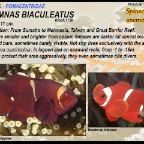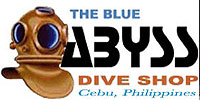Anemonefish-Pomacentridae
ANEMONEFISH - Subfam. AMPHIPRIONINAE
This is probably the most known fish species on a coral reef. Anemonefish are very bad swimmers and hardly swim two meters away from their anemone. Incase of danger, they will hide between the poisonous tentacles of their symbiotic host. The poison of the anemone does not harm them because they grew up in the anemone and because of being in constant contact with the poisonous slime they builded up immunity against it. Only from the Clarks anemonefish (Amphiprion clarkii) it is known that they are immune from birth. Also the anemonefish protects the anemone from polyp-feeders like butterflyfish who try to feed on the anemones tentacles. This way of symbiosis is a very common way of life on a coral reef. Every anemone has his own big dominant female anemonefish who's in charge and keeps down the growth of the other anemonefish living with her. If this dominant female dies or disappears for some reason, than the first male in rank will change sex and become the new dominant female. Anemonefish are one of the few species who take care of their own eggs. The female will stick the eggs on a place next to the anemone which they cleaned before, than the male takes care and protect the egg mass from potential egg robbers. The larvae will hatch during night around a week later and travel with the current. Two to three weeks later they will settle themselves on a matching anemone. The Amphiprion family feed on certain algae and plankton. There are around a thousand different anemones from which only ten species get inhabit by anemonefish. After the movie "Nemo" I was a bit afraid for the anemonefish population because of the demand and export of the species, but luckily enough do many of this family breed well in captivity so they don't have to go and steal them of a coral reef somewhere. Length: 11 cm.Distribution: From Sumatra to Melanesia, Taiwan and Great Barrier Reef.Males are smaller and brighter from colour, females are darker till almost black.Subdued bars, sometimes barely visible. Not shy, lives exclusively with the anemoneEntacmaea quadricolour. In lagoon and on seaward reefs, from -1 to -16m.Females protect their area aggressively, they even sometimes bite divers.
Length: 13 cm.Distribution: From the Arabian Gulf to Fiji, S- Japan, Maldives and New Caledonia.Very variable ground colour, orange to black and orange, white or black tail.One of the most common anemonefish you can find on a coral reef. At seaward andclear lagoon reefs down to -55 m. Lives in 10 different anemones: Cryptodendrum adhaesivum, Entacmaea quadricolour, Heteractis aurora, H. crispa, H. magnifica, H. malu, Macrodactyla doreensis, Stichodactyla gigantea, S. haddoni and S. mertensii.
Length: 14 cm.Distribution: Andaman Sea to Malaysia, Sumatra and Java in Indonesia.Reddish orange with black blotch (variable in size) on rear body.Juveniles are completely red with a white bar behind the head.Lives with the anemones Heteractis crispa and Entacmaea quadricolor. Silty coastal waters and bays, from -2 to -15m.
Length: 14 cm.Distribution: Andaman Sea to Malaysia, Sumatra and Java in Indonesia.Reddish orange with black blotch (variable in size) on rear body.Juveniles are completely red with a white bar behind the head.Lives with the anemones Heteractis crispa and Entacmaea quadricolor. Silty coastal waters and bays, from -2 to -15m.
Length: 14 cm.Distribution: From Sumatra to the Solomon Is, Ryukyus and NW- Australia.Very similar to A. akallopisos but has a wider white stripe on the face and back.In shallow lagoons and seaward reefs from -1 to -20m, prefers protected areas.Lives with the anemones Heteractis crispa and Stichodactyla mertensii.Length: 13 cm.Distribution: From Thailand to French Polynesia, Ryukyus and n- Australia.Pale face, two broad white saddles(can differ from size), one behind the head and the other mid-body. White margin on dorsal and tail fin.Lives with the anemones Heteractis crispa and Stychodactyla haddoni. Among sandy-seagrass areas, from -2 to -30 m. Distribution: From Thailand to SW- Japan, Samoa and Great Barrier Reef.Very easy to recognize by the white vertical line on the side of the head. Fine white dorsal line over the back. Lives in symbiosis with anemones, H. crispa, Macrodactyla doreensis, Stychodactyla gigantuea but mostly found on Heteractis magnifica.In lagoons and seaward reefs, including turbid areas from -1 to -15 m.
Length: 11 cm.Distribution: from the Andaman Sea to SW- Japan, the Moluccas and NW- Australia.An al time favorite for many snorkelers, divers and aquarium lovers.Orange with 3 broad white bars, middle bar wider at central body, pointing towardsthe head. Lives on the anemones Heteractis magnifica, Stichodactyla gigantea and S. mertensii. In lagoons and seaward reefs, including turbid areas, from -1 to -15 m.
Length: 14 cm.Distribution: S- China Sea, Malaysia , W- Indonesia, SE- Borneo, SW- Japan.Orange-red with a bluish-black edged white bar behind the head. Males are bigger and have black sides. Can have small differences, depending the region. Very similar to A. rubrocictus and A. melanopus. Lives in and among the anemone Entacmaea quadricolor. On reef flats and lagoon reefs, down to -18 m.
Length: 14 cm.Distribution: from the Red Sea to Chagos Is. (Gulf of Aden).Very similar to A. chagosensis but doesn’t have dark pelvic fins. Common, lives with the anemones Heteractis crispa, H. magnifica, H. aurora and Stychodactyla gigantea. On protected fringing reefs, from -1 to -30 m























